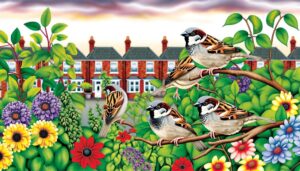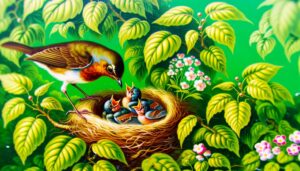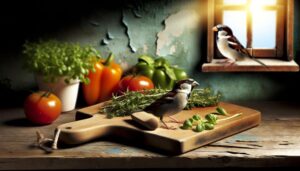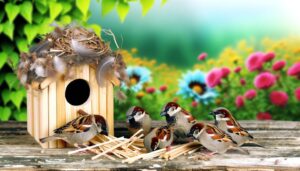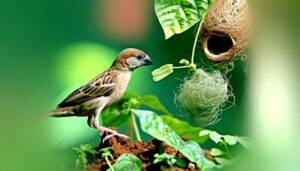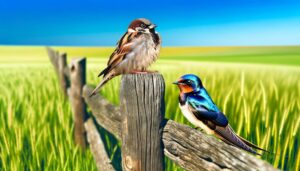Understanding How Long Do House Sparrows Live: A Complete Guide
House Sparrows (Passer domesticus) typically exhibit a lifespan of 3 to 5 years in their natural habitat. Survival rates are influenced by predation, food availability, and disease prevalence.
Juvenile mortality is high, with over 50% perishing in their first year, while adult survival rates range between 40-60%. Under ideal conditions without predation and with best nutrition, some individuals may surpass the average lifespan.
In captivity, where predators and diseases are less prevalent, House Sparrows can live up to 12-14 years. Factors such as diet quality, environmental conditions, and disease presence critically determine these survival outcomes.
There are more intriguing aspects to their existence worth exploring.
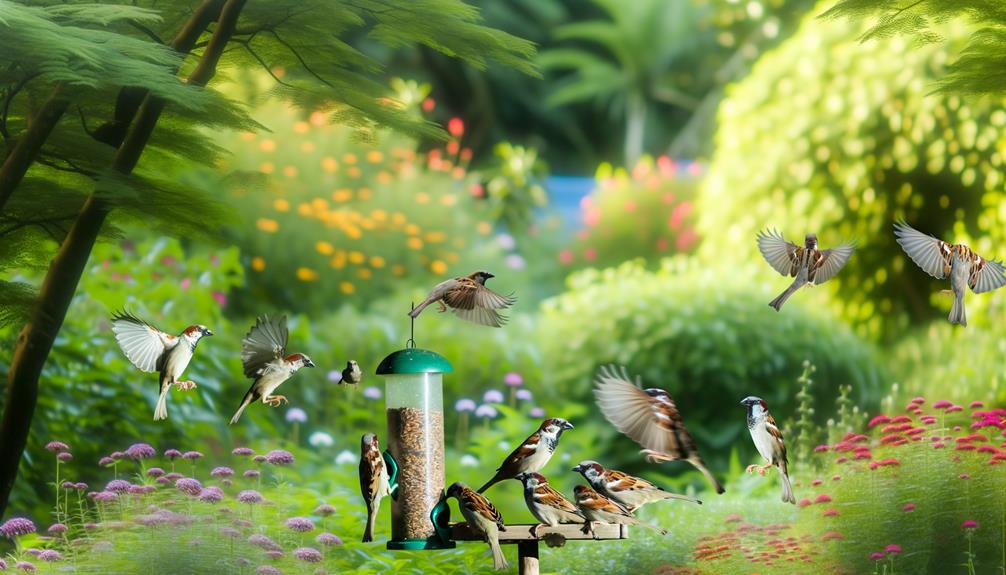
Key Takeaways
- House sparrows have an average lifespan of 3 to 5 years in the wild.
- Juvenile house sparrows face over 50% mortality within their first year.
- Adult house sparrows have survival rates estimated between 40-60%.
- In captivity, house sparrows can live significantly longer, up to 12 to 14 years.
- Predation, disease, and nutrition quality are critical factors influencing their lifespan.
Average Lifespan of House Sparrows
On average, house sparrows (Passer domesticus) have a lifespan ranging from 3 to 5 years in the wild, though some individuals may live longer under ideal conditions. Detailed banding studies and long-term monitoring have revealed that survival rates vary considerably depending on factors such as predation, food availability, and disease prevalence.
Data indicates that the first year of life is the most perilous, with juvenile mortality rates often surpassing 50%. Adult survival rates generally improve, with annual survival rates estimated around 40-60%. Seasonal variations also impact lifespan, as harsh winters can lead to higher mortality.
Consequently, while the average lifespan provides a general understanding, the true longevity of house sparrows is influenced by a complex interplay of ecological factors.
Lifespan in the Wild Vs. Captivity
Comparing the lifespan of house sparrows in the wild versus captivity reveals significant differences driven by variations in environmental stresses, resource availability, and predation pressures.
In the wild, house sparrows (Passer domesticus) typically exhibit an average lifespan of 3 to 5 years, with high mortality rates due to predation, disease, and food scarcity.
Conversely, in captivity, these birds can live up to 12 to 14 years, benefiting from controlled environments that mitigate predation risks and provide consistent nutrition and medical care.
Data indicates that the reduced exposure to environmental hazards and the provision of veterinary services are pivotal in extending lifespan.
These observations underscore the impact of external factors on avian longevity, highlighting the disparity between natural and artificial habitats.
Factors Affecting Longevity
In examining the factors influencing the longevity of house sparrows, it becomes evident that diet quality, predation pressure, disease prevalence, and environmental conditions play important roles.
Data indicates that optimal nourishment can greatly enhance lifespan, while nutritional deficiencies detrimentally impact health and survival. Additionally, disease prevalence, particularly avian malaria and poxvirus, has been documented to reduce life expectancy.
Consider the following factors:
- Diet Quality: Access to diverse and nutrient-rich food sources bolsters overall health and longevity.
- Disease Prevalence: Incidences of infectious diseases can lead to increased mortality rates.
- Environmental Conditions: Harsh weather and habitat degradation adversely affect survival rates.
Understanding these parameters offers insights into the multifaceted determinants of house sparrow longevity.
Predation and Survival Rates
Predation represents a significant variable impacting the survival rates of house sparrows. Studies indicate that predation pressure from raptors and domestic cats can markedly reduce their lifespan. Detailed observations reveal that approximately 30% of juvenile sparrows fall prey to avian predators within their first year.
Raptors such as hawks and falcons are particularly adept at capturing sparrows in flight or while foraging. Additionally, domestic cats contribute to a substantial mortality rate, often hunting sparrows near human habitations. Data-driven models suggest that predation not only reduces average lifespan but also affects reproductive success, as sparrows must expend considerable energy on vigilance and evasive maneuvers.
Consequently, predation remains a critical factor influencing the population dynamics and longevity of house sparrows.
Disease and Health Issues
House sparrows are susceptible to various diseases, including avian malaria, poxvirus, and bacterial infections such as Salmonella. These health issues have a notable impact on their lifespan, as evidenced by studies showing increased mortality rates linked to disease prevalence.
Understanding the correlation between disease exposure and survival rates is essential for developing effective conservation strategies.
Common Sparrow Diseases
Evaluating the health and longevity of house sparrows requires a detailed understanding of common diseases such as avian pox, salmonellosis, and trichomoniasis, which have a noteworthy impact on their populations. These diseases manifest distinct symptoms and affect sparrows in various ways:
- Avian Pox: Characterized by lesions on the skin and mucous membranes, avian pox is transmitted via mosquito bites and direct contact, impeding feeding and mobility to a considerable extent.
- Salmonellosis: Caused by Salmonella bacteria, this disease leads to gastrointestinal distress and systemic infection, often resulting in high mortality rates during outbreaks.
- Trichomoniasis: A protozoan parasite, Trichomonas gallinae, causes caseous lesions in the upper digestive tract, obstructing food passage and leading to starvation.
These diseases collectively contribute to morbidity and mortality, shaping sparrow population dynamics.
Impact on Lifespan
Understanding the prevalence and impact of diseases such as avian pox, salmonellosis, and trichomoniasis is essential in evaluating how these health issues influence the lifespan of house sparrows.
Avian pox, caused by the Avipoxvirus, manifests as cutaneous lesions, impairing feeding and mobility, thereby reducing survival rates.
Salmonellosis, a bacterial infection from the genus Salmonella, leads to enteritis and septicemia, with high mortality rates observed in infected populations.
Trichomoniasis, caused by the protozoan Trichomonas gallinae, results in necrotic lesions in the upper digestive tract, obstructing food intake and leading to starvation.
Epidemiological data reveal a notable reduction in average lifespan, with disease prevalence correlating inversely with survival probabilities, emphasizing the critical role of health management in conservation efforts.
Impact of Urbanization
Urbanization greatly affects house sparrows through habitat alteration and changes in food resource availability.
Studies indicate a correlation between urban density and reduced nesting sites, which subsequently impacts breeding success and population stability.
Additionally, shifts in food sources, often towards anthropogenic waste, have been observed to influence nutritional intake and overall health parameters in urban sparrow populations.
Habitat Alteration Effects
Urban expansion and habitat alteration have notably affected the survival rates and life expectancy of house sparrows (Passer domesticus), as evidenced by numerous ecological studies. Key findings highlight several critical impacts:
- Habitat Loss: Urbanization reduces natural habitats, leading to a decrease in nesting sites and shelter, directly impacting sparrow populations.
- Pollution: Increased air and noise pollution in urban areas have been shown to disrupt sparrow communication and breeding behaviors, resulting in lower reproductive success.
- Predation Pressures: Urban environments often introduce new predators, including domestic cats and invasive species, which markedly heighten mortality rates among sparrows.
These factors collectively underscore the complex interplay between urbanization and avian population dynamics, necessitating targeted conservation efforts to mitigate adverse outcomes.
Food Resource Availability
The availability of food resources in urban landscapes greatly influences the survival and reproductive success of house sparrows. Studies indicate notable variations in diet quality and accessibility compared to rural habitats.
Urban environments often provide an abundance of anthropogenic food sources, but these are frequently lower in nutritional value. Research has shown urban house sparrows have access to higher quantities of processed foods, which lack essential nutrients required for best health and breeding success. Consequently, this dietary shift can lead to malnutrition, reduced immune function, and lower reproductive rates.
Conversely, rural habitats offer more natural food sources like seeds and insects, which are richer in necessary proteins and vitamins. This divergence in food resource availability is a critical determinant of house sparrow longevity and population dynamics.
Seasonal and Climatic Influences
Seasonal and climatic influences heavily impact the lifespan of house sparrows, with variations in temperature, food availability, and predation pressures contributing to survival rates. Empirical data indicate that extreme weather conditions can markedly reduce sparrow populations.
Temperature Extremes: Severe cold or heat can lead to increased mortality, as sparrows struggle to maintain body heat or hydration.
Food Scarcity: Seasonal changes often affect food availability, particularly in winter when natural resources are limited, leading to starvation.
Predation Rates: Climatic variations can alter predator populations and behaviors, increasing predation risks during certain seasons.
These factors, interconnected with environmental conditions, underscore the complexity of survival dynamics for house sparrows, providing valuable insights into their ecological adaptability and resilience.
Nutrition and Diet
A critical determinant of house sparrow longevity is their access to a varied and nutrient-rich diet, which directly influences their overall health and reproductive success. House sparrows (Passer domesticus) primarily consume seeds and grains, comprising about 70% of their diet.
Studies have shown that a diet supplemented with insects, particularly during breeding seasons, provides essential proteins and fats, thereby enhancing survival rates. Data indicates that urban sparrows have adapted to include human-derived food sources, which, while abundant, often lack necessary nutrients.
As a result, this dietary shift has been associated with decreased lifespan and increased susceptibility to diseases. Ensuring a balanced diet rich in natural seeds and insects is paramount for optimizing the health and longevity of house sparrows.
Breeding and Reproductive Life
The breeding season for house sparrows typically spans from early spring to late summer, with peak activity observed in April and May.
Nest construction is characterized by the utilization of varied materials such as grasses, feathers, and paper, forming a well-insulated and concealed environment.
Parental investment includes biparental care, where both males and females equally participate in feeding and protecting the offspring until fledging.
Mating Season Timing
House sparrows typically commence their mating season in early spring, marked by intricate courtship behaviors and vocalizations that facilitate pair bonding and territory establishment. Observations reveal that these behaviors include:
- Chirrup Calls: Males emit repetitive calls to attract females and establish dominance within their territory.
- Wing Fluttering: Both sexes engage in wing fluttering, a display that signals receptiveness and interest in mating.
- Feather Puffing: Males puff up their feathers to appear larger and more appealing to potential mates.
The onset of mating season is primarily influenced by photoperiod and temperature changes, which cue hormonal shifts in sparrows. These behaviors, reinforced by environmental stimuli, ensure ideal conditions for breeding and subsequent offspring survival, contributing to the species' reproductive success.
Nest Construction Details
Nest construction in sparrows begins with the selection of suitable sites, often in cavities or structures that provide shelter and protection from predators. Preferred locations include eaves, crevices, and man-made structures.
Both males and females participate in gathering materials, which consist of grasses, feathers, string, and paper. The nest is typically cup-shaped, with a diameter ranging from 10-15 cm.
Sparrows exhibit a high degree of adaptability, often constructing nests in a variety of urban and rural environments. Studies indicate that nest construction can take from 2 to 10 days, depending on material availability and environmental conditions.
Successful nest construction is essential for reproductive success, offering an ideal environment for egg incubation and chick development.
Offspring Care Strategies
Sparrows frequently exhibit careful care strategies for their offspring, ensuring high survival rates through coordinated parental efforts in feeding, protection, and temperature regulation. These avian species engage in complex behaviors to improve the developmental conditions of their young.
Notable strategies include:
- Biparental Care: Both male and female sparrows participate actively in provisioning food, increasing the nutritional intake and growth rates of the nestlings.
- Nest Defense: Parents exhibit aggressive behaviors toward potential predators, reducing predation risk and enhancing offspring survival.
- Thermoregulation: Adults meticulously adjust their brooding patterns, maintaining ideal thermal conditions within the nest, essential for the proper development of the chicks.
Such strategies underscore the adaptive mechanisms sparrows employ, reflecting their evolutionary success in varied environments.
Human Interaction Effects
The impact of human interaction on the lifespan of house sparrows has been extensively studied, revealing significant consequences that range from altered feeding patterns to increased exposure to pollutants. Urban environments, where human activity is intense, often lead to nutritional imbalances due to the ingestion of processed foods. Additionally, pollutants such as heavy metals and pesticides contribute to physiological stress, reducing overall lifespan. Research indicates that sparrows in urban areas exhibit a higher prevalence of diseases, attributed to both direct human contact and environmental degradation.
| Factors | Consequences |
|---|---|
| Altered Feeding | Nutritional Imbalances |
| Pollutants | Physiological Stress, Reduced Lifespan |
| Disease Prevalence | Higher in Urban Areas |
These findings underscore the need for mitigating adverse human impacts to support healthier avian populations.
Conclusion
The lifespan of house sparrows is influenced by a variety of factors. Wild populations generally have shorter lifespans due to threats like predation, disease, and environmental challenges. In contrast, sparrows in captivity tend to live longer. Nutrition, breeding practices, and human interactions are crucial determinants of their longevity. This avian species symbolizes resilience in the face of adversity, illustrating the complex dynamics of survival and adaptation.
House sparrows navigate a delicate balance between nature and nurture, showcasing how different aspects of their environment impact their lifespan.
Factors such as predation, disease, and environmental challenges often limit the lifespans of wild sparrows, whereas those in captivity benefit from better conditions and care, leading to extended longevity.
Nutrition, breeding practices, and human interactions are key elements influencing the lifespan of house sparrows, highlighting the intricate interplay between biology and environment.
The house sparrow serves as a symbol of resilience, highlighting the intricate dance between nature and nurture that shapes their lifespan.

